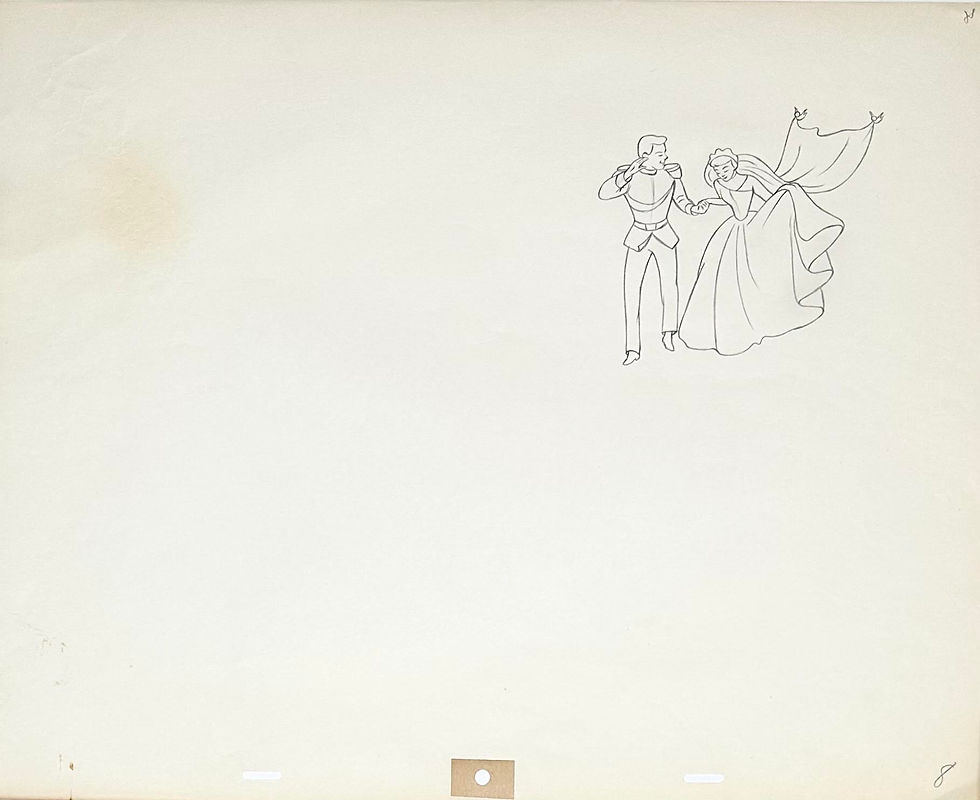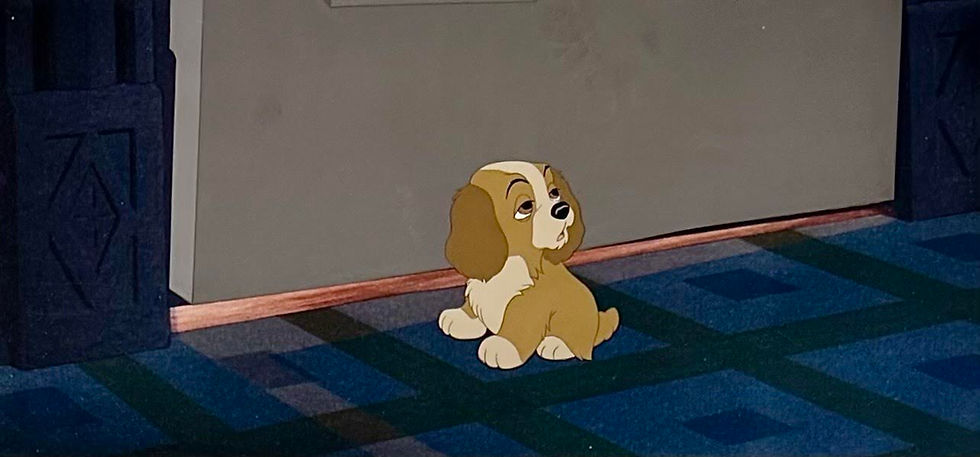Original Production Animation Cel of Figaro, Fish, and Water Effects from "Pinocchio," 1940
- Untitled Art Gallery

- Jan 21, 2024
- 3 min read

Original hand painted and hand inked production animation cels of Figaro, Fish, and Water Effects from "Pinocchio," 1940, Walt Disney Studios; Set over a Courvoisier painted wood veneer background; Matted with original Courvoisier calligraphy titled mat; Size - Figaro & Fish: 4 x 4", Image 6 x 6 1/4", Mat 12 1/4 x 11 1/2"; Matted.
"Never saw so many! Here's another one! Enough for weeks! Here's a big one. Keep them in there, Figaro!" - Geppetto
"Pinocchio," 1940 was the second animated feature film produced by Disney, and followed on the success of "Snow White and the Seven Dwarfs." 1937. It was released to theaters by RKO Radio Pictures on February 23, 1940 and was based on the Italian children's novel "The Adventures of Pinocchio" by Carlo Collodi. The general plot of the film involves an old wood-carver named Geppetto, who carves a wooden puppet that he names Pinocchio. One night the puppet is brought to life by the Blue Fairy, who informs him that he can become a real boy if he proves himself to be "brave, truthful, and unselfish". Pinocchio's journey to become a real boy is challenged by his encounters with an array of scrupulous characters.
"Pinocchio" became the first animated feature to win an Academy Award; it won for both Best Music - Original Score and for Best Music - Original Song for "When You Wish Upon A Star." Most critics and audiences agree that "Pinocchio" is among the finest Disney features ever made, and one of the greatest animated films of all time. In 1994, it was added to the United States National Film Registry as being "culturally, historically, or aesthetically significant."
Due to the huge success of "Snow White," Walt Disney wanted more famous voice actors for "Pinocchio." He cast popular singer Cliff Edwards (who had made the first record selling over a million copies) as Jiminy Cricket. Disney also wanted the character of Pinocchio to be voiced by a real child. The role ended up going to twelve year old actor Dickie Jones, who had previously been in Frank Capra's enormous Hollywood hit, "Mr. Smith Goes to Washington."
Animation began in September 1938 and just as in "Snow White," live-action footage was shot for "Pinocchio" with the actors playing the scenes; which was supervised by Hamilton Luske. The animators then used the footage as a guide for their animation drawings by studying the human movement and then incorporating many of those poses and scenes. The title character was animated by Milt Kahl (initial design), Frank Thomas, and Ollie Johnston. "When I was doing Pinocchio," Johnston said, "I thought of the character being real, a living person, not a drawing."
Figaro is Geppetto's pet Tuxedo Cat and was Walt Disney's favorite character in the film. He loved the kitten so much, he wanted him to appear in as many scenes as possible. Once production on "Pinocchio" was completed; Walt made him Minnie Mouse's pet, replacing her dog Fifi. Figaro was also given his own series of cartoon shorts, as well as costarring in other cartoon shorts with Pluto.
The master Walt Disney animator Eric Larson was in charge of animating Figaro, and based the kitten's design on the childlike personality of his own nephew. The famous character actor Mel Blanc (known as "The Man of Thousand Voices") provided the voice of Figaro.
This is an absolutely wonderful original production animation cel setup of Geppetto's cat Figaro pawing at a fish. When Geppetto, Figaro, and Cleo are trapped inside of the whale Monstro, they must resort to fishing inside the beast in order to survive. A great full figure image of Figaro, his eyes are open, and he is in a very action oriented pose. Also set over the Courvoisier air brush background are cels of a Fish and Water Effects. The piece is still sealed and retains it's original Courvoisier calligraphy titled mat. A beautiful piece of artwork from one of the greatest Walt Disney films; and featuring one of Walt's most loved characters. A fantastic addition to any animation art collection!
#Pinocchio #JiminyCricket #CliffEdwards #BlueFairy #Geppetto #WaltDisney #Disney #untitledartgallery #animation #animationart #cel #animationdrawing #productiondrawing #DickieJones #MiltKahl #FrankThomas #OllieJohnston #Bach #SandyStrother #JoeGrant #JackCampbell #MargeChampion #HamiltonLuske #JohannSebastianBach #Bach #OskarFischinger #JeanHarlow #EvelynVenable #EricLarson #Figaro #Cleo #MelBlanc #DisneyCat






